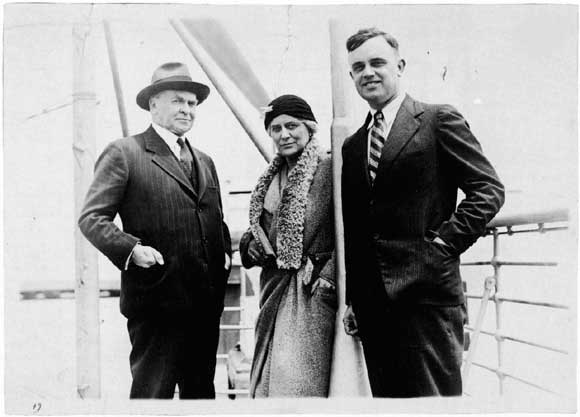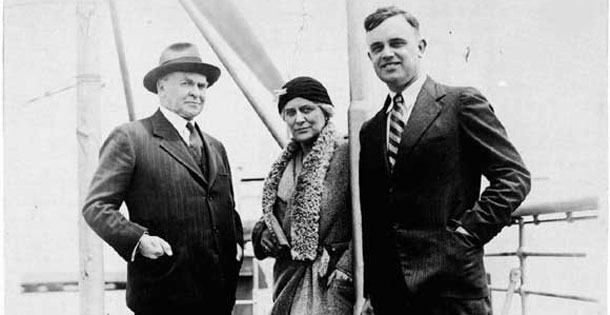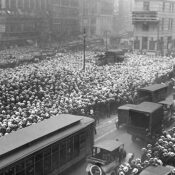
Photo from University of Chicago Centennial Catalogues.
The story should sound familiar: an American security expert leaves his job and publishes an account of the government’s top-secret surveillance program. Foreign governments are outraged when they learn that America has been intercepting and reading their confidential communications. The U.S. government is equally outraged by the revelations, but unable to silence the whistle blower because the story has been published in the pages of a popular magazine—The Saturday Evening Post, in this case.
The year was 1931 and the security expert was a former cryptanalyst named Herbert O. Yardley, the former head of the army’s Cipher Bureau.
In a series of Post articles, Yardley detailed his work for the government during the first world war. When the war was over, he remained in the Cipher Bureau—eventually nicknamed The Black Chamber—to break the diplomatic codes of foreign governments. His greatest achievement was deciphering the 35,000 words of Japan’s Diplomatic Code. It enabled America to read the confidential bargaining points that Tokyo sent its diplomats at the Washington Naval Conference in 1921. The U.S. used this knowledge to negotiate a sharp decrease in the size of Japan’s navy.
Several years later, then-Secretary of State Henry L. Stimson was angered to learn about Yardley’s unit, and that it had cracked the diplomatic codes of over 40 countries. He shut down the Cipher Bureau, offering his famous justification, “Gentlemen do not read each other’s mail.”
The Black Chamber ceased operations in late 1929. The remainder of its operations transferred to a “signals intelligence” unit in the army.
Out of work with a skill no one needed in civilian America, Yardley turned to writing. Over the next two years, he wrote The American Black Chamber, which recounted his work in government code-breaking. Before it went on sale, Yardley offered portions of his story to the Post.
Beginning in the May 4 issue, readers learned how America’s intelligence services were unprepared for the first world war. Yardley wrote of his hurried efforts to build a team of code breakers, and of that team’s successes in intercepting messages within German codes, ciphers, and cryptograms.
The American Black Chamber proved extremely popular. It sold 17,000 copies in the U.S, and almost twice as many copies in Japan, which learned what Yardley had been doing with its codes.
American authorities were furious. Yardley had exposed over a decade of work in his book and, they believed, had compromised the security of its agents. The revelations also put the Western Union in an awkward position, since their telegraph offices had given the Black Chamber access to foreign governments’ coded messages.
In the 1980s, the National Security Agency released a report on Yardley’s revelations, which concluded, “There had never been anything like it. In today’s terms, it was as if an NSA employee had publicly revealed the compete communications intelligence operations for the past twelve years…and had, for good measure, included actual…communications not only of our adversaries but of our allies as well.”
Sound familiar? Such a breach of security today would bring legal retribution. But in 1931, there were no laws that could convict or silence Yardley.
One reason Yardley’s account was so damaging was his readiness to name code-makers and code-breakers. In one Post excerpt, Yardley described how he had recruited his code-breakers from hundreds of letters from would-be cryptanalysts.
“The writers either offered the Government their services or had new and indecipherable codes for sale. From among the former group, I hurriedly selected a few whose letters read most convincingly, and ordered the writers commissioned as captains. The first of these captains to report was Dr. John M. Manly, a small quiet-spoken scholar, who was head of the English department of the University of Chicago. To our great good luck. Captain Manly had the rare and precious gift of originality of mind, and developed into the most brilliant of all our cyptographers.”
Yardley made no effort to hide the identity of John Matthews Manley, Ph.D., who was still living and teaching at the University of Chicago when this article appeared.
In addition to exposing its operations, Yardley also revealed the government’s blunders, particularly its inept security prior to the war. In the Post excerpts, Yardley told readers how America’s secretary of state, William Jennings Bryan, failed to secure his diplomatic communications.
“If the spirit moved him he would stop at a telegraph office and file a wire to some embassy in plain English. The next day an inquiry would come: ‘Just received uncoded, undated telegram signed ‘Bryan.’ Advise if authentic.’”
Even when state department officials used the code, it was so transparent that Yardley easily broke it to read messages to President Wilson. He knew that “other countries used cryptographers not only to devise their own codes but to read the codes of foreign governments. Probably they were reading ours.”
To prove the need for a modern cryptologic program, he wrote “An Exposition On The Solutions of American Diplomatic Codes.” He gave it to his superior officer, who replied, “You mean to say that our codes are not safe?…I don’t believe it.”
Yardley saw an opportunity to prove how easily a skilled cryptographer could obtain government secrets.
“Some months earlier he had changed the combination of the code-book safe. I saw him do it and noticed that he chuckled to himself. This was Saturday, and I was to open up Sunday morning. He failed to tell me the new combination and I forgot to ask. This I realized as I opened the office Sunday morning. He would not permit us to carry a string of combination figures in our pockets. Instead, we needed only to remember a name. The telephone number opposite that name in the phone book, anagramed and distorted in a certain way, was the combination.”
“I thought it would be great fun to open the safe by deduction. I could do it if I only could think straight enough.”
“He had thought of a name and laughed. What name was on everyone’s lips? The president had just announced his engagement (to Edith Bolling Galt).—Mrs. Galt!”
“I leafed the phone book to her name and spun the safe dial.
“A moment later, the phone on my desk rang. ‘Yardley, I forgot to give you the combination—’ [my superior] began.
“’No need. The safe is open.’”
“’Open?” he yelled. ‘Who left it open?’”
“’No one. I just fiddled around until I opened it.’”
A month later, his superior introduced a new method for encoding the department’s dispatches. A few weeks later, Yardley handed him a system for breaking the new code. It was this sort of success that led to the government giving him a staff and letting him loose on intercepted telegrams from the world’s governments.
Considering the uncertain fate of NSA whistle-blower Edward Snowden, you might wonder what happened to Yardley. He was never charged with any crime, and in later years managed to find work as a cryptanalyst in Canada and China after his book was published, but the U.S. government would never hire him again. He spent his later years writing spy novels and a successful book entitled Education of a Poker Player, in which he gave mathematical analyses of poker strategies.
In 1999, despite all the damage he was said to have caused to national security, his name was included in the Hall of Honor at the National Security Agency.
Become a Saturday Evening Post member and enjoy unlimited access. Subscribe now




Comments
Herbert Yardley, cryptologist,
Breaking foreign government codes,
Then wrote a tell all book – the gist,
Embarrassing the U.S. loads.
This was pre Espionage Act
Amending to make such a crime.
Yardley profited – that’s a fact,
Until a stroke ended his time,
Which was before the NSA,
And harsh treatment of tattletales.
One wonders what Yardley would say
Of Edward Snowden’s tell travails.
Yardley’s told secrets brought no shame.
He’s in NSA’s Hall of Fame.